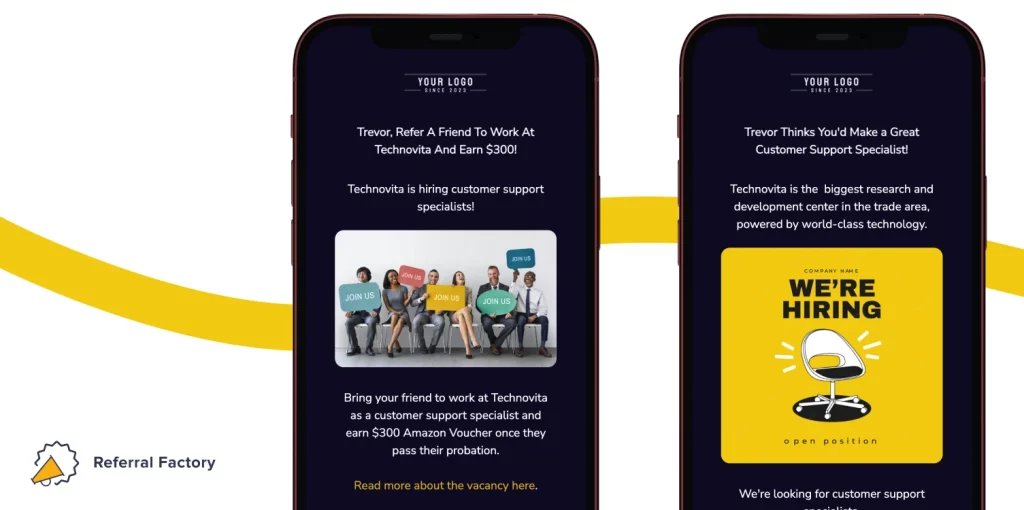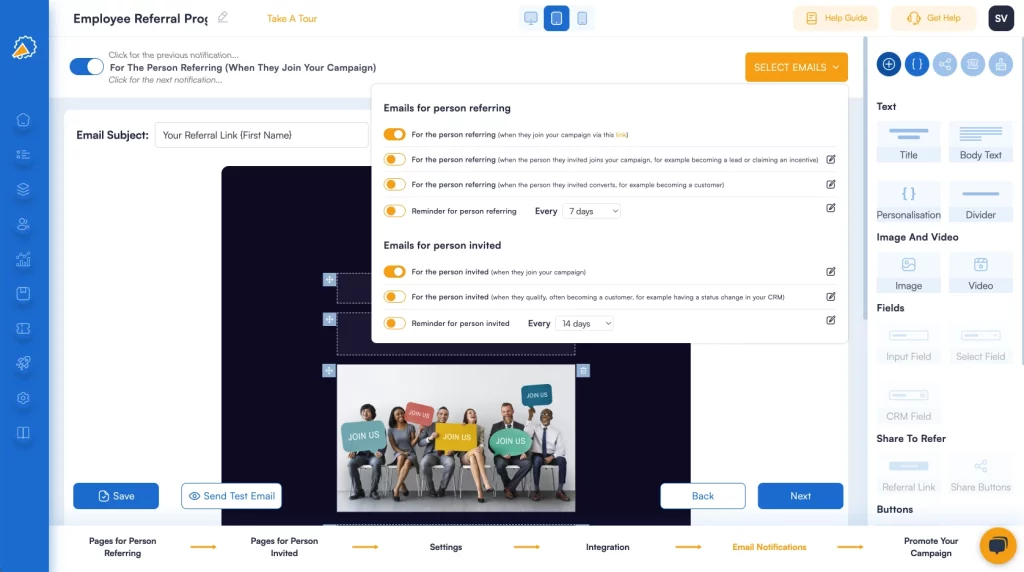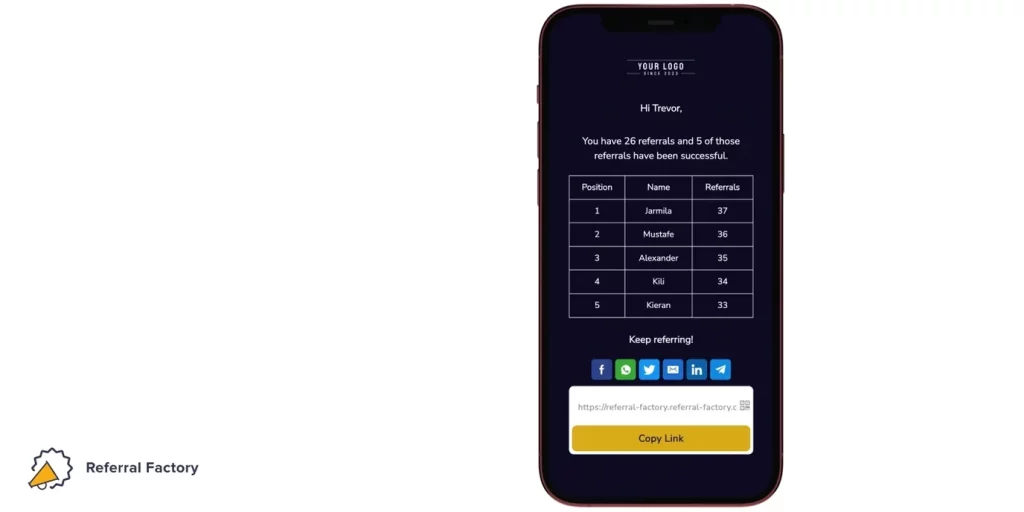Employee Referral Program: A Step-by-Step Guide to Success
Traditional methods of recruiting for vacant positions in most cases will lead to an influx of candidates who in most cases don’t meet the requirements for the role, resulting in you spending most of your hiring resources searching through resumes of unqualified candidates. That’s where an employee referral program comes in!
According to an Indeed survey, 74% of employers said candidates sourced from employee referral programs were extremely qualified for the role.
Referral systems work the same way in sales: companies rely on referrals to generate high-quality business leads and referral leads, and the same principle applies when finding strong candidates. Plus, with referral software, tracking your employee referrals isn’t going to be a drain on your HR department.
You can build your own employee referral program in seconds using our tool 👇
Table of Contents
What Is An Employee Referral Program?
An employee referral program is a highly effective method that companies utilize to draw on their network and seek recommendations from qualified candidates for job openings in their organization. In exchange, when these recommendations result in the successful hiring of a candidate, companies provide a reward to those who assisted in the hiring process. This program encourages employees to refer individuals from their personal and professional networks who they believe would be a good fit for the company.
This mirrors how referral programs help companies win business sales leads—your employees’ networks are already pre-qualified.
By tapping into the connections and knowledge of your existing employees, you can increase the likelihood of finding qualified candidates who are a good cultural fit for your organization!
How To Build a Powerful Employee Referral Program
Building an employee referral program can seem like a daunting task. And it can be. But with this step-by-step guide, you’ll be getting new referrals for your open jobs in no time!
Step 1: Create an Employee Referral Program Strategy
Building a powerful employee referral program requires careful planning and strategic implementation. To ensure success, there are several key elements that are necessary for an effective program:
Clear job post
The first step is to create a clear and detailed job post for the positions you are looking to fill. Clearly outline the job requirements, responsibilities, and desired qualifications. This will help your employees understand what types of candidates you are looking for and increase the chances of them referring suitable candidates.
Incentives
Offering rewards for successful referrals can significantly boost employee participation. Decide on a suitable reward structure, such as a monetary bonus, gift cards, or additional paid time off. Consider offering higher incentives for harder-to-fill positions or for referrals that result in successful hires. Make sure the incentives are attractive and aligned with your company’s budget and culture. Helping your employees feel incentivized will drive better results!
Referral incentives work because people trust recommendations, whether they’re bringing in new hires or winning business leads from referrals.
Step 2: Build the Employee Referral Program
Next, you need to effectively communicate the employee referral program to your employees. Make sure they are aware of the program, how it works, and what rewards are available. If you have developer resources on your team you can always brief them on how you want your campaign to work and they can build it exactly to spec. The downside with this is that every time you want to make a change to your program, you’ll need them to do it.
Off-the-shelf referral program software like Referral Factory can help you build an awesome employee referral program that’s 100% on-brand, without having to hire a developer or learn any code. You can also then create a campaign for each position you want to fill.
Using Referral Factory, you can build an employee referral program in a matter of seconds – just enter your website below
You can also use our employee referral program template to get started.

💡 It’s super important to make it easy for your employees to refer their friends. With Referral Factory’s software, all your employees will need to do is share their unique referral link with their network!
Step 3: Promote the Employee Referral Program
To encourage employee participation in the referral program, you need to promote it regularly and consistently. Highlight the benefits of referring candidates and remind employees of the incentives they can earn. Just like in referral campaigns built to capture business sales leads, consistent communication boosts participation. You can also create promotional materials, such as posters or flyers, and display them in common areas or break rooms.
The first thing you should do once your referral campaign is live is to send out a company-wide notification informing all employees about the campaign and encourage them to refer.
Step 4: Provide Regular Updates
Keep your employees engaged and informed by providing regular updates on the status of their referrals. Let them know when a referral has been received, when the candidate has been interviewed, and whether or not the candidate has been hired. With Referral Factory’s built-in email notifications, it’s easy to keep your employees updated.

You can even set up a referral dashboard, where your employees can log in to see how many people they have referred and whether any of those applications have been successful! This is a great place to include some gamification, like a referral leaderboard or countdown timer.

Step 5: Track your Employee Referrals
When you start to get referrals, you need to track your referral program effectively by monitoring its performance. Here are some of the metrics you need to keep an eye on
👉 The number of referrals that were made
👉 How many referrals were successfully converted
👉 How many positions you were able to fill compared to other channels
👉 How managers and employees feel about the program
You will also need to track all of these things so you can stay on top of issuing rewards and incentives (depending on the type of campaign) to your employees who have successfully referred their friends. Or you can automatically reward your employees using Referral Factory!
What are the Advantages and Disadvantages of an Employee Referral Program?
Employee referral programs can be highly beneficial for companies, but they also come with their own set of disadvantages. Here are some advantages and disadvantages of implementing an employee referral program:
Advantages:
- Quality candidates: One of the greatest advantages of an employee referral program is that it often leads to high-quality candidates. Employees are likely to refer candidates who they believe will fit well within the company culture and possess the necessary skills and qualifications. This can result in a higher rate of successful hires.
- Cost-effective: Implementing an employee referral program can be cost-effective compared to other recruitment methods. Traditional recruitment methods such as job boards or hiring agencies can be expensive. Employee referrals, on the other hand, typically have a lower cost per hire.
- Faster hiring process: With an employee referral program, the hiring process can be accelerated. Referrals tend to be pre-screened by the referring employee, saving time and effort in the initial screening stage of the hiring process. This can lead to faster recruitment and reduced time-to-fill positions.
- Increased employee engagement: Implementing an employee referral program can boost employee engagement. Employees who participate in the program feel valued and are more likely to be actively involved in the company’s growth. Referring candidates can also provide a sense of pride and satisfaction.
- Stronger networks lead to better outcomes: Employees often refer people from strong professional circles. The same networks companies rely on to generate business leads and referral leads. This overlap can strengthen both hiring and sales pipelines over time.
Disadvantages:
- Limited Pool of Candidates: One of the main disadvantages of an employee referral program is the potential limitation in the pool of candidates. Relying solely on employee referrals may result in a lack of diversity in the candidate pool, as employees are more likely to refer individuals who are similar to themselves. This can lead to a lack of diversity in terms of skills, backgrounds, and perspectives.
- Nepotism and Bias: Employee referral programs can also be susceptible to nepotism and bias. Employees may refer friends or family members who may not be the most qualified candidates for the job. This can result in a lack of equal opportunities for all candidates and a potential decrease in overall fairness in the hiring process.
- Strained Relationships: Implementing an employee referral program can sometimes strain relationships within the workplace. If an employee’s referred candidate is not hired, it can lead to resentment or tension between the referring employee and the hiring manager or the candidate themselves. This can negatively impact team dynamics and morale.
- Overdependence on Referrals: Companies that heavily rely on employee referrals may become too reliant on this recruitment method. As a result, they may neglect other effective recruitment strategies, such as job boards or hiring agencies. This overdependence can limit the company’s ability to attract a diverse pool of candidates and hinder overall recruitment efforts.
What Incentives Do Companies Offer for Successful Employee Referrals?
Employee referral programs are an effective way for companies to leverage their existing workforce to find top talent. To encourage employees to refer qualified candidates, companies often offer enticing incentives. These incentives can vary depending on the company’s budget, culture, and industry. Here are some common incentives that companies offer for successful employee referrals:
- Cash bonuses: One of the most popular incentives is a cash bonus. Companies may offer a fixed amount or a percentage of the new hire’s salary as a reward for successful referrals. The amount can vary depending on the level of the position being filled.
- Gift cards or vouchers: Another popular option is to provide employees with gift cards or vouchers for popular retailers, restaurants, or online platforms. This allows employees to choose a reward that aligns with their personal preferences.
- Extra vacation days: Some companies offer additional vacation days as an incentive for successful referrals. This can be a valuable perk for employees who value work-life balance and want more time to relax and rejuvenate.
- Recognition and awards: Companies can recognize employees publicly for their successful referrals through awards and certificates. This recognition can be given during team meetings, company events, or through internal communication channels.
- Career advancement opportunities: In addition to immediate rewards, some companies offer employees the opportunity for career advancement as an incentive for successful referrals. This can include promotions, pay raises, or priority consideration for internal positions.
- Unique experiences: Companies may offer unique experiences as incentives, such as tickets to concerts, exclusive access to events, or special trips. These experiences can create memorable rewards for employees and motivate them to refer top talent
- Charitable donations: Some companies offer employees the option to donate their referral bonus to a charity of their choice. This allows employees to give back to causes they care about and adds a philanthropic element to the referral program.
- Training and development opportunities: Companies can offer employees the opportunity to attend conferences, workshops, or training programs as an incentive for successful referrals. This not only rewards employees but also helps them enhance their skills and knowledge.
- Flexible work arrangements: Flexibility in work schedules or remote work options can be an enticing incentive for employees. By allowing employees to have more control over their work-life balance, companies can attract and retain top talent through their referral program.
- Employee recognition programs: Some companies have employee recognition programs in place, where employees can accumulate points or rewards for various achievements, including successful referrals. These accumulated points can then be redeemed for a range of rewards, such as travel vouchers, electronics, or even additional paid time off.
It’s important for companies to choose incentives that align with their company culture and values. By offering incentives that are meaningful and attractive to employees, companies can increase employee participation in the referral program and ultimately improve their recruitment efforts.
What Measures Can Companies Take to Ensure Fairness in an Employee Referral Program?
Employee referral programs can be a win-win situation for both companies and employees. They allow businesses to tap into their employees’ networks and find top talent, while also offering incentives for employees who refer successful candidates. However, to ensure fairness in these programs, companies should take certain measures. Here are some steps businesses can take to ensure fairness in an employee referral program:
- Establish clear guidelines: It is important to clearly outline the rules and expectations of the referral program. Clearly define what types of candidates are eligible for referral, what positions are open for referrals, and any other criteria that need to be met. This will ensure that all employees have a fair and equal opportunity to participate.
- Provide equal incentives: Companies should provide equal incentives for all employees who refer a successful candidate. This can be in the form of monetary rewards, additional vacation days, or other perks. Ensuring that the rewards are the same for all employees will ensure fairness and prevent any perception of favoritism.
- Communicate the referral process: Clearly communicate the referral process to all employees. Explain how they can submit a referral, what information is required, and the steps involved in the hiring process. Transparent communication will help minimize any confusion or misunderstandings and ensure everyone has access to the same information.
- Monitor and evaluate referrals objectively: Implement a fair evaluation process to assess the referred candidates. Use objective measures to evaluate their qualifications and fit for the role, such as skills, experience, and cultural fit. Avoid any subjective biases or preferences that could compromise the fairness of the evaluation process.
- Address concerns and provide feedback: Create an open and transparent feedback system where employees can express any concerns or questions they may have about the referral program. Address these concerns promptly and provide feedback on the status of their referrals. This will help build trust and ensure that employees feel their referrals are being taken seriously.
- Regularly review and update the program: Employee referral programs should be regularly reviewed and updated to ensure they remain fair and effective. Solicit feedback from employees and make necessary adjustments to address any issues or concerns that arise. This will show employees that their input is valued and that the company is committed to creating a fair and inclusive referral program.
Fairness in an employee referral program is crucial to its success and employee satisfaction. By implementing clear guidelines, providing equal incentives, transparent communication, objective evaluation processes, addressing concerns, and regularly reviewing and updating the program, companies can ensure that their referral programs are fair and beneficial for all employees.
Great Employee Referral Program Examples
Many companies use referral systems not only to find great hires, but also to drive growth by capturing business leads and other high-intent referral contacts. Here are some examples of successful employee referral programs:
1. Google
Google has one of the most well-known employee referral programs. They offer a generous cash reward to employees who refer successful candidates. They also provide regular updates on the status of referrals, keeping employees engaged and informed throughout the process.
2. Zappos
Zappos, an online shoe and clothing retailer, incentivizes employee referrals with a cash reward and a unique “Zollars” currency that can be used to purchase products from the company. They also set up a referral leaderboard, creating friendly competition among employees and further motivating them to refer candidates.
3. Facebook
Facebook not only offers a cash reward for successful referrals, but they also provide additional perks, such as a VIP pass to their annual developer conference or an invitation to exclusive events. This adds an extra incentive for employees to participate in the referral program.
4. HubSpot
HubSpot, a marketing software company, uses a tiered system for their employee referral program. The more successful referrals an employee makes, the greater the rewards they receive. This motivates employees to continue referring candidates and helps drive the success of the program.
These examples highlight the importance of providing regular updates, offering attractive incentives, and creating a sense of competition among employees. Go here if you want to see more referral program ideas.
Why Employee Referral Programs Strengthen More Than Just Hiring
Employee referral programs do far more than shorten your hiring cycle or improve candidate quality. When employees share opportunities with their networks, they rely on the same behavior that helps companies win business leads through referral campaigns: trusted recommendations spreading through strong professional circles.
By building a structured program, offering clear incentives, and keeping participants informed, you create a referral engine that supports both HR and broader business growth. A team that’s used to sharing referral links for hiring is far more likely to share product updates, partnership opportunities, and other campaigns that generate warm business sales leads.
Prioritizing referrals means tapping into networks that already trust you, and that trust compounds over time across your talent pipeline, your culture, and your bottom line.



